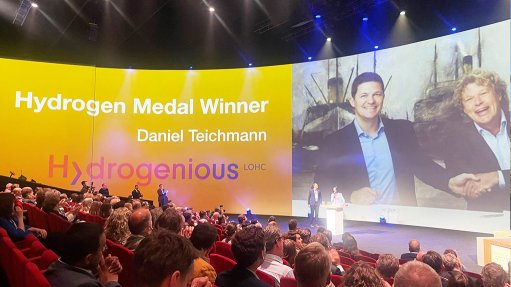
Hydrogenious founder and CEO Dr Daniel Teichmann (left) after receiving a gold medal in the Netherlands for the promotion of platinum-based hydrogen.
JOHANNESBURG (miningweekly.com) – Thrifted platinum is continuing to play its critical catalytic role in the significant strides that have been made towards making liquid organic hydrogen carrier (LOHC) competitive, SherLOHCk reported on Monday.
South Africa forms part of the international SherLOHCk project that is enabling clean hydrogen to be transported and traded globally in the same way as oil and in the process make use of existing oil infrastructure.
As a clean and sustainable energy carrier, which produces no emissions except water, hydrogen has the potential to become the universal energy carrier, but without the environmental impact.
SherLOHCk’s aim is to take LOHC down the cost curve and lower the energy it requires to facilitate catalytic reactions.
Hydrogenious LOHC Technologies, part of the South Africa-linked AP Ventures’ investment portfolio, has developed a technology to bind hydrogen to an oil, allowing for more efficient and lower-cost transport in ambient conditions
Meanwhile, the SherLOHCk project, which received financial support from the Clean Hydrogen Partnership and the European Union, is focused on creating cost-effective and environment-friendly catalysts that enhance the efficiency of both hydrogenation and dehydrogenation processes, and multiple catalyst formulations have been prepared and tested, achieving a low-platinum-content bimetallic catalyst as the most promising ones.
Approaches to reactor design and thermal management have been developed to reduce the overall energy consumption of the LOHC system. Novel catalytic system architecture and internal heating have reportedly proved a stable behaviour in continuous mode.
Initial testing results of a scaled-up LOHC technology demonstration system are described as being very promising.
Moreover, preliminary findings of environmental-impact assessments point to LOHC being techno-economically sound and environment-friendly.
By pushing the boundaries of LOHC technology, the way is being paved for sustainable hydrogen storage and transport.
“These advancements are crucial for the future of green energy,” SherLOHCk stated in a release to Mining Weekly, as they address the practical and economic challenges of hydrogen logistics.
Hydrogen is thus poised as the viable way of rendering sun and wind energy transportable and tradable on a global scale amid the storage density of hydrogen in LOHC being up to five times higher than conventional high-pressure storage. A cubic metre of LOHC can carry about 57 kg of hydrogen. Thus, transport capacities on trucks, trains, buses, ships and planes are increased, and total cost of hydrogen supply to customers reduced.
Hydrogenious of Germany have developed an efficient and completely safe method for storing and transporting hydrogen – and therefore renewable energy – by chemically binding the hydrogen molecules to an easy-to-handle oil, through LOHC.
The carrier oil is readily available. The fluid used is non-toxic, hardly flammable, non-explosive and remains in a useable and convenient liquid state through a broad temperature range of –39 ºC to 390 ºC, which makes it possible to transport the LOHC in the existing global fuel infrastructure.
The technology as such is thus simple since it is based on a reversible catalytic hydrogenation and then dehydrogenation process. After the release of the hydrogen, the carrier substance can be reused as carrier for several hundred times. With hydrogen being the smallest and the lightest molecule, the efficient storage and transport of hydrogen is the key to connect the upstream and downstream of the complete hydrogen supply chain.
The storage density of hydrogen in the LOHC system is up to five times higher than conventional high-pressure storage. A cubic metre of LOHC can carry about 57 kg of hydrogen. As a result, the transport capacities on trucks, trains or ships have increased, thereby significantly reducing total cost for hydrogen supply to the customer.
To enable a green hydrogen world on a global scale, strong partners have been brought on board. For the joint construction of large-scale industrial plants are companies such as MAN Energy Solutions and Frames. Strategic partners and investors include Royal Vopak, Covestro and Mitsubishi Corporation.
“We’ve developed an efficient and completely safe method for storing and transporting hydrogen – and therefore renewable energy – by chemically binding the hydrogen molecules to an easy-to-handle oil, through LOHC,” Hydrogenious founder and CEO Dr Daniel Teichmann, who has just received a gold medal award in the Netherlands for his company’s contribution, told Mining Weekly in an earlier interview.
The South African government’s grasp of the hydrogen nettle is evidenced by valuable research and development strides that have been taken by Hydrogen South Africa (HySA), a creation of the Department of Science and Innovation.
For some time, HySA has been developing local skills for the hydrogen economy, while the Department of Trade, Industry and Competition has been creating special economic zones where local manufacture is being incentivised. The State-owned Industrial Development Corporation has also been playing a supporting role and the Public Investment Corporation has matched the R1.3-billion investment of Anglo American Platinum in AP Ventures, a venture capital fund that invests in the hydrogen value chain, fuel cell electric mobility and energy storage markets.